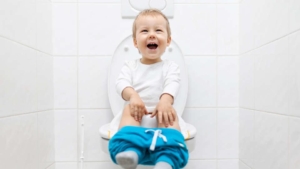Let me paint the picture for you…
My 2.5 year old is TERRIFIED to poop in the potty because she doesn’t like the feeling. In return, she gets extremely constipated. My husband and I chase her around the bathroom trying to reason with her that if she doesn’t go, she will feel worse. She continues to scream and act irrationally because she is clearly upset that she is being forced to do something she is scared to accomplish.
This was our life for about 3 years with our oldest daughter. Every time she needed to go, we ended up in a battle that usually ended with an enema…it was awful seeing her struggle like that. We were frustrated, she was scared and sad, and everyone ended up EXHAUSTED in the end. Don’t let our mistakes be your mistakes. Here are the tips for childhood constipation and helping your child “go” that we discovered…
First, let’s talk constipation and what it is:
Did you know about 5% of general pediatric office visits are due to constipation complaints? Twenty-five percent of all referrals to pediatric gastroenterologists are for constipation.
Constipation is common in kids. Constipation happens when a child (or adult) is unable to or has difficulty emptying their bowels.
Typically, this is due to hardened stool, which can occur for several reasons, including poor diet, dehydration, medications, or a medical problem.
How to Treat Constipation Naturally
The goal of constipation treatment is to relieve it and re-establish normal bathroom stooling patterns.
There are several ways to treat constipation naturally. The method used will depend on your child’s age and how serious the problem is.
First and foremost, I suggest you try a natural constipation relief approach, using natural laxative agents coming from food.
This also includes establishing a healthy diet and lifestyle that supports your child’s regularity.
This will help every child with constipation.
In severe cases of chronic constipation, medications may be prescribed to “clean out” your child’s intestinal tract.
Some medications soften the stool (such as Miralax, a stimulant laxative), while others help clear out the stool (an enema).
You should always consult with your pediatrician before giving laxatives or enemas to your child.
You probably already know a high fiber diet, which includes both insoluble fibers and soluble fibers is key to keeping the digestive system working normally. It makes your child’s stool easier to pass.
Insoluble fibers are not dissolvable in water. They add bulk to your child’s stool. Examples are wheat bran and vegetables.
Soluble fibers dissolve in water. They help lower cholesterol and keep blood sugar levels normal. Examples are oats, barley and fruit.
Your child should drink enough water, also. Of course, exercise is beneficial to the child who struggles with constipation.
Bulking your child’s diet up with fiber may not always work initially.
In fact, a high fiber diet may make constipation worse in some children.
Fiber adds bulk and draws water into the stool, making it softer and helping it move through the intestine.
However, added fiber may add too much bulk to the stool, stretching the rectum and colon and interfering with the sense of needing to go, especially in children who tend to withhold their stool.
If your child is “clogged up,” extra fiber combined with poor water and fluid intake can lead to an impaction. This may worsen constipation and block the intestinal tract.
Natural Sources of Fiber-Containing Foods
Pear Nectar.
Fruit nectars are different than fruit juices. Juices that are labeled 100% fruit juice are just that—100% juice.
Nectars, on the other hand, may contain added sugar or the addition of other juices.
Because of this, nectars may be more likely to stimulate a bowel movement.
I suggest this as a quick home remedy for all my families who deal with chronic constipation. I’ve seen it work in children who are non-mobile due to a medical condition such as cerebral palsy or developmental delay, or other mobility constraint.
Tip: warm up the nectar for additional movement potential.
Berries.
The seeds on berries like strawberries add roughage and bulk to stools.
Cherries or apricots.
These fruits are high in fiber; apricots contain sorbitol, which may have a natural laxative effect.
Seeds.
Sesame, poppy, flax and chia are some examples of seeds; they add a punch of fiber to food.
Add them to cereal, or grind in a coffee bean grinder and mix into hot cereal such as oatmeal, or layer atop cold high fiber cereal.
Prunes.
I used this with my first child! I added an ounce of prune juice to her formula every day as we were transitioning to solid food, just to keep things moving along.
Use prune puree or prune juice—they are both high in fiber.
Did you know that 1 cup of prune juice contains about 3 grams of fiber?
Molasses.
This syrup has a good source of magnesium, which can act as a bowel stimulant. Mix into smoothies and hot cereal.
Beans and lentils.
You know these are high in fiber, now you just need to figure out how to work them in your child’s diet!
Try salads, soups, quesadilla, and bean dip.
Whole grains.
Hot oatmeal, barley, quinoa, and more. Start shifting your refined grains over to whole grain foods for extra fiber.
Breads and cereals.
High fiber and low sugar cereals.
Don’t forget to look at the serving size! Target at least 2 grams of fiber per serving.
Dried fruit.
Raisins are a standout, as they have tartaric acid.
Researchers have found that one small box per day helped to increase transit time in the gut (translated: bowel contents traveled faster through the intestine).
Nuts.
Fibrous and fabulous. If your child isn’t allergic, dig in!
Fiber supplements.
These can make constipation worse as they are dehydrating, and potentially encourage constipation.
Check with your doctor before using them.
More Quick Natural Constipation Relief Tips
Water.
Children should drink enough water and consume plenty of non-dairy sources of fluid, such as juices. Watch out for the sugar content of beverages though!
Mint tea.
If your child is willing to drink hot tea, perhaps a mint tea would help. Menthol is known to relax muscles…and the entire gastrointestinal tract is one long muscle.
Senna.
Herbal preparations of senna such as senna tea are not regulated by the FDA or proven safe for children. They could be contaminated and harmful for your child.
Senna is found in tablets or syrup form, such as Ex-Lax or Senekot, and may be used with children who have encopresis.
ONLY use this under the guidance of your doctor.
Probiotics.
There is little evidence in favor of probiotics as a cure for constipation, however, anecdotally, I have heard from patients that it can help soften and regulate bowel movements.
We need more research in this area.
Dairy.
Removal of dairy may help relieve a child’s constipation.
I suggest trying this for two weeks, and if you see improvement, continue the dairy-free diet.
You will need to substitute a fortified, non-dairy substitute, such as soy milk, so that your child gets a good source of calcium and vitamin D.
Be sure to cut back on milk if your child is a big drinker.
Two to three cups of dairy per day is enough (that’s 16 – 24 ounces per day), and more than that could be contributing to constipation.
Does your child struggle with constipation?




0 Comments